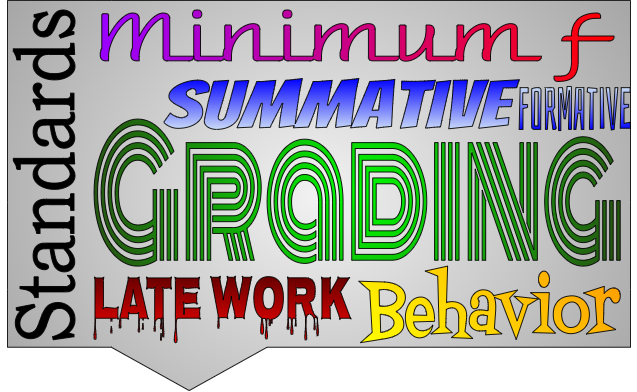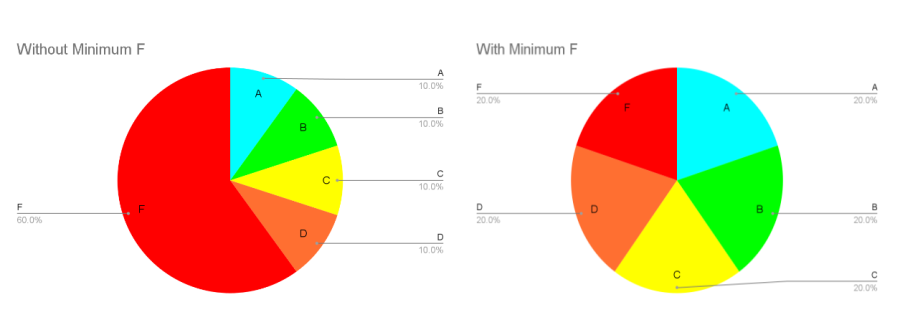School district adapts to grade reform
February 10, 2023
Graphic lists various grading reform policies CCSD instituted for the current school year.
CCSD has been implementing changes to its grading system since the 2021-2022 school year. These changes include the minimum F, policies on late work, efforts to separate grades from behaviors and changes in the percentage of formative and summative work. While these reforms have student success in mind, there are many challenges to implementing them.
The Assessment Department, led by Becca Meyer, Director, has worked closely with the Grading Reform Committee to help schools implement these changes.
“The shift in how we communicate student progress is a necessary one to ensure we are communicating accurate and meaningful information to our students and families,” Meyer said. “It is critical for educators to clearly communicate how students are progressing on their path to mastery to ensure gaps in learning can be filled and successes can be celebrated.”
Struggles in minimum F
Two graphics demonstrate the unfair practice of making an F grade a greater percentage of the grading scale.
One of these changes in grades is the minimum F. If a student turns in an assignment incomplete, or gets most of the questions wrong, or doesn’t turn in any work at all, they will receive a 50% instead of a zero or low score that could tank their grade.
“I appreciate the minimum F,” said senior Will Cox. “But overall it makes kids less energetic because it gives kids a low bar to participate.”
A major problem with minimum F is that it minimizes repercussions for students who don’t try. Unfortunately this can lead students not to complete any of their work with the assurance that they still will receive half credit. It also makes final exams worth a great deal less, as if students don’t take their exam at all their grade would only drop five percent, potentially not even changing their letter grade.
“I don’t like the minimum F, it doesn’t make me work hard,” said sophomore Evyn Pallett. “You don’t get that in college. It doesn’t make kids do formative assignments and they don’t do their work.”
“Watching students place less and less importance on their work knowing that a minimum F (50%) ‘isn’t so bad’ compared to a 0% has hurt their overall education,” said Silverado teacher Matthew Philips. “It has become more difficult motivating students who are okay receiving D’s. By earning at least a 72.5% in the first quarter, they can get a minimum F for all assignments and tests in the second quarter, and their semester exam, and still pass with a 60% D… which sadly is true.”
Michele Rhine, Assessment Department Coordinator, said, “Assigning the minimum score of 50 allows for students who don’t always learn things the first time to recover their grade when the content is mastered.”
Under the old grading system, a score of anywhere from a zero to a 59.99 is a failure. That makes sense, because students who receive scores that low likely don’t really understand the concept, or are just randomly guessing. However, this can be a problem because those low scores significantly lower grades.
The idea is to make it possible to overcome failure. Without the minimum F, a student could dig themselves into a hole that’s mathematically impossible to get out of. But students only concerned with passing have less motivation to do their classwork.
Kimberly Todd, Assessment Department Coordinator, said, “By using an equal interval scale, where each letter grade accounts for 20 percent of the total scale, the grading system is not disproportionately weighted toward failure.”
As shown by the graph above, without the minimum F, most of the scale is a failing grade. With the minimum F, the scale is balanced and each grade has an equal percent of the scale. This is similar to the 4.0 system some schools use in that each grade has equal weight.
Summative makes formative worth less
Another change implemented with grading reform is a change in how formative and summative assignments affect grades differently. Summative assignments such as tests, essays and projects now take up a higher percentage of the grade year after year.
Makayla Nicholes, a junior, said, “I feel like formative is kinda useless because most everything now is summative.”
Some teachers make most assignments summative now, because they see that students don’t do formative work. If it doesn’t directly affect their grade, students don’t see a reason for doing it. But sometimes all the assignments come together and it’s important to do all of them for a teacher’s overall plan.
“One of the biggest issues with grading reform in my classes has been motivating students to find value in completing formative assessments,” said Silverado teacher Kylene Vidal. “This has resulted in students ‘checking out’ of assignments they feel are unimportant, many times not realizing that how they perform on formative assignments helps dictate what lessons I focus on in class.”
According to Oxford Languages, the word formative is an adjective, meaning “serving to form something, especially having a profound and lasting influence on a person’s development.” Formative work is the rock learning is based on. It is assignments that give you practice with those skills, give you the opportunity to make mistakes and figure out what you did wrong, so you are ready for the test. Summative work is opportunities for students to show what they have learned, or their “mastery of standards” as officials would say. It all comes down to if you know the standard.
“You can think of formative work as practice and summative as game day,” said Todd. “Meaningful formative work is the pathway to a successful summative experience.”
You have to practice to score goals, but how you do during practice does not directly affect the score of the game. You still have to show up and practice to succeed.
According to a recent Silverado graduate Abigail Jackson, now a college freshman, “The summative vs formative grading scale is really similar to the ones most college professors use, with some classes having around 70% of the grade relying on major tests.”
The grading system can actually help prepare students for college. Silverado had implemented a grading system where summative work counts for 80% of the grade and formative work counts for 20%.
Formative work should be an opportunity to learn and make mistakes, so when facing critical summative assignments, students can be prepared. Of course, that doesn’t really work if students don’t do the formative work. It is imperative students practice skills, but lowering the weight of formative work can take away incentive to do that work and get that practice.
Late work leniency
Another issue is late work, which unfortunately is complicated. It’s important for students to learn to turn things in on time, a critical skill for later in life, college, jobs, yada yada. But on the other hand, people have bad days, and there should be some mercy if someone messes up. If someone doesn’t do an assignment on time, then they no longer see any point in doing the assignment, so they don’t do the work. Some people have legitimate reasons for not being able to turn work in on time. There are also classes in which it is essential for things to be done on time, especially if the class is producing something.
Bianca Lutchen, Silverado assistant principal said, “Students who may have a significant event in their life are not discouraged from continuing to put forth effort after an extenuating circumstance.”
If someone has a drastic event in their life that causes them to fall behind in school work, they should be able to catch up.
On the other hand, if there are no immediate deadlines, students do not do the work until the last possible minute, and make a habit of not doing work until it’s due. It is easier to do work in class, when the teacher is explaining things and is available to help, and it is easier to keep track of things if you get them done immediately. The new policy can hurt students who procrastinate a lot and help students who need a little mercy from time to time.
In the 2021-2022 school year, students could wait until the end of the quarter to turn in assignments. People have a natural tendency to procrastinate, and do things at that last minute, struggling to plan and do things in a timely manner. Students would wait until the end of the quarter to do their work, then would be severely overwhelmed by all the work they needed to complete.
This year at Silverado, students have three school days after the original deadline of an assignment to complete it or make it up until the assignment is locked. This prevents people from procrastinating too much.
It’s good to be merciful, to allow students to redo things so that if they have messed up, they can remedy that. However, if students can redo anything, there are students who don’t try the first time. There are also perfectionists who want to redo things if they get anything less than 100%. It takes time for teachers to have to do retakes outside of school hours, especially if they create a new exam for the retake.
To retake assignments, Silverado asks you to fill out a reflection form, in which you are supposed to put what concepts you did not understand and what you did to study it. If a student retakes a test without studying, they likely would get the same grade. If you study before reassessment, you will understand it better and get a better grade. Also, you can use the back of the form as scratch paper for a math test.
Behavior and 2nd chances
It’s good to be merciful, to allow students to redo things so that if they have messed up, they can remedy that. However, if students can redo anything, there are students who don’t try the first time. There are also perfectionists who want to redo things if they get anything less than 100%. It takes time for teachers to have to do retakes outside of school hours, especially if they create a new exam for the retake.
To retake assignments, Silverado asks you to fill out a reflection form, in which you are supposed to put what concepts you did not understand and what you did to study it. If a student retakes a test without studying, they likely would get the same grade. If you study before reassessment, you will understand it better and get a better grade. Also, you can use the back of the form as scratch paper for a math test.
“Grading reform has minimized the impact of non-academic factors for students by focusing on students’ knowledge and skills,” said Lutchen. “At Silverado, we now have consistent weighting and categories in the grade book and we have a consistent reassessment policy that includes opportunities for reflection to ensure student mastery.”
A lot of grading reform is an effort to separate grades from behaviors. The idea is that your grade should solely reflect what you know, and that your grade is not a measure of your ability to be on time and respectful. That’s a completely different grade, your citizenship or behavior grade.
“Academic grades represent your mastery of course standards and curriculum,” said Christine Mamaradlo-Rodriguez, Assessment Department Coordinator. “On the other hand, behavior grades represent how well you can perform habits of work. If you smash both of these things together into one grade, it makes it hard to understand what the grade really means.”
The point of trying to separate behavior grades from academic grades is to show students what they need to work on, to show whether you don’t understand the concept or have a behavior issue. It is quite possible students are struggling with a standard because of a behavior issue. Although sometimes it is difficult to tell exactly what a behavior grade means because the decisions behind them can be fairly subjective, teachers can now add more specific comments to identify specifically where students are struggling. The thing about behavior is that grading it is always going to be fairly subjective, which is why it shouldn’t be included in your academic grade.
In conclusion…
Change is hard. Grading reform is asking people to entirely change their mindset on grades, and to be completely successful everyone needs to be on board. It’s asking for students to come to school ready to participate in all the things done in class, with occasional summative assignments checking to see how well students really understand it.
“Grading reform is a mindset change that requires everyone on board to be successful,” said Vidal. “In theory, it should be a positive change, as it strives to eliminate behavior from academic grading. In practice, it has been hard on CCSD teachers because it was presented as an initiative by which to abide, instead of the systemic change that it is.”
Since elementary school, we have been focused on struggling to get the points to get whatever grade, using the easiest way possible to get it. Grades are a form of extrinsic motivation, and numerous studies show that that is not optimal for success. It would be better if everyone was motivated by a genuine, internal desire to achieve, to learn. There are a myriad of untapped resources at every student’s disposal. The system relies on students making use of these resources and striving to learn. That’s what all of this comes down to.



Natalie Carter • May 9, 2023 at 12:19 pm
Great article, Naomi. It helped me to understand the grading system a little better. I still feel like those you don’t submit anything should get a slightly different and lower grade than 50%, though, or those that turn something in, even if they bomb it should be a little higher than 50%.